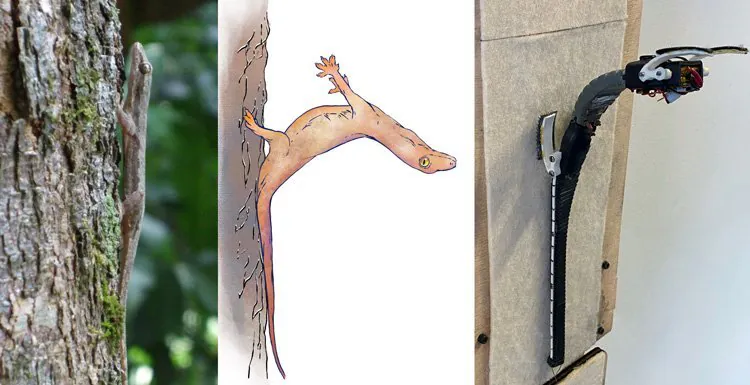Robotics
Geckos’ Crash-Landing Abilities Could Be Used in Robotics

Researchers at the University of California, Berkeley and the Max Planck Institute for Intelligent Systems in Stuttgart, Germany have demonstrated how geckos use their tails to maneuver midair. This ability allows them to correct themselves when falling after losing their grip, and it can also help them propel across the surface of a pond.
The findings will be published this week in the Nature journal Communications Biology.
These techniques are highly useful in robotics, and they are already being implemented in gecko-like robots.
Surprising Findings About Geckos
Robert Full is a UC Berkeley professor of integrative biology, and Adria Jusufi is a faculty member at the Max Planck Research School for Intelligent Systems and former UC Berkeley doctoral student. The two made an important and surprising new finding that geckos also use their tails to help recover when they take a header into a tree.
Head-first crashes are fairly common among geckos, and Jusufi documented this with high-speed video cameras.
“Observing the geckos from elevation in the rainforest canopy was eye-opening. Before take-off, they would move their head up-and-down, and side-to-side to view the landing target prior to jumping off, as if to estimate the travel distance,” Jusufi said.
The videos show that the gecko, in this case the common Asian flat-tailed house gecko, grabs the trunk with its clawed and padded toes when colliding head-on with the tree. This helps its head and shoulders rebound, and the gecko has leverage to press its tail against the trunk, which prevents it from tumbling backwards.
“Far from stalling, some of these lizards are still accelerating upon impact,” Jusufi said. “They crash headfirst, pitch back head over heels at an extreme angle from the vertical — they look like a bookstand sticking away from the tree — anchored only by their rear legs and tail as they dissipate the impact energy. With the fall-arresting reflex happening so fast, only slow motion video could reveal the underlying mechanism.”
According to the scientists, other small and lightweight leaping animals like lizards might also use these techniques.
“They may have longer glides that are more equilibrium glides, and they land differently, but, for example, if they are trying to escape, they choose to do this kind of behavior, in part because size matters,” Full said. “When you're that small, you have options that aren't solutions for big things. So, this is sort of a body-mediated solution that you don't have if you're bigger.”
Structures similar to gecko tails could be used to help stabilize flying robots like drones, helping them land on vertical surfaces.
The researchers are the first to document, mathematically model and reproduce this behavior in a soft robot.
“Exaptations are structures that have been co-opted for many behaviors, no matter what that structure evolved for originally, and here's one that you wouldn't expect,” Full said. “You can see how that incredible capability of being robust can allow these exaptations.”
“Until recently tails had not received as much attention as legs or wings, but people are now realizing that we should think of these animals as five-legged, in a way — pentapedal,” Jusufi said.
According to Full, robotic engineers are adding increasingly more functions to robots, and they are learning they can introduce a new part for every capability.
“As we evolve our robots and physical systems, engineers all want to do more things. And guess what? At some point, you can't optimize a robot for everything,” he said. “You have to use things for other behaviors in order to get those behaviors.”
Building the Robot
The researchers built a tailed robot after creating its parts with Carbon M2, a state-of-the-art 3D printer specifically designed for soft structures. The feet were equipped with Velcro so it could stick upon contact, and the tail had a mechanism that would make it press downward when the front legs hit a surface and slip.
The tailed robot demonstrated similar success when making hard landings. In nature, geckos with tails successfully land on vertical surfaces without falling 87% of the time. Tailless robots have demonstrated an ability to land successfully 15% of the time in trials, but the new tailed robot was able to land 55% of the time in trials.
The researchers also found that robots with tails half the length of the head and body combined were almost as successful as longer ones that were the snout-vent length. They also found that short-tailed robots required twice the foot force to stay attached to the tree.
The team will keep studying geckos and look for new principles to apply to robots, especially soft robots on vertical surfaces.
“Evolution is not about optimality and perfection, but instead, it's about sufficiency. The just-good-enough solution really plays into giving you a breadth of capabilities so that you're far more robust in challenging environments,” Full said. “Evolution looks more like a tinkerer who never really knows what they'll produce and uses everything that's at their disposal to make something that's workable.”
“Small arboreal animals without obvious morphological adaptations for flight are increasingly being found to exhibit surprising ability for mid-air maneuvering. Soft robotic physical models can help decipher the control of such mechanically mediated solutions to landing,” Jusufi said.














